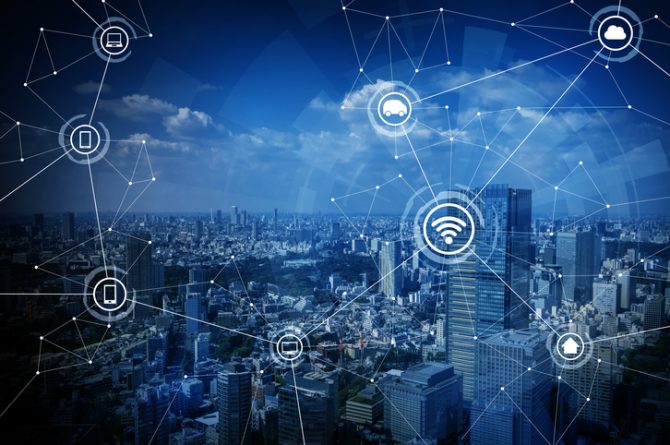
Critical components in smart city creation
By Thomas McElroy, founder, Level-1 Global Solutions
Automation / Robotics Electronics Engineering Software Engineering IoT cities IoT smartPower, data and infrastructure make the city more ‘user-friendly’
The development of infrastructure for smart cities has been growing for many years and continues to move forward despite disruption from current public health and safety concerns. Interestingly, however, while the smart city phenomenon promises to deliver more efficient and technologically advanced cities with more digital accessibility for all citizens, there are still many who don’t quite know what a smart city is.
In essence, smart cities use technology and information systems to digitally connect a variety of civic-related sectors and Internet solutions—public transportation, utilities, parks and recreation, city infrastructures, etc.—all by using data-driven approaches that make the city more “user-friendly.” Ultimately, this data can be used to improve multiple aspects of life within the community.

Smart city and wireless communication network. Source: Getty Images
Smart cities also utilize a variety of advanced technologies, such as Artificial Intelligence (AI) and the Internet of Things (IoT), for example, to acquire, share and analyze data. Relevant data can then be converted into valuable insights that city managers can use to make decisions that help the city operate more efficiently for its citizens.
In the world of smart cities, we’re likely to see a number of trends in the next several years, including:
- Increased real-time monitoring of all types of data, from light levels to air quality
- Technology to better direct traffic and make transit more efficient
- Improved waste management systems
- Public safety and emergency service technologies
- Greater digitization of many municipal processes
- A focus on security and privacy
- Greater adoption of mobile and cellular solutions
But, the use of technologies to enhance these services and systems is not without its challenges. Chief among them is the lack of critical infrastructure.
Implementation challenges are often related to coverage and capacity. Security and privacy are of great concern as well. Disturbingly, it is estimated that approximately 20% of the digital devices currently deployed by municipal governments contain malware and ransomware. As the number of devices on an IoT system increases, hackers will continue to look for new ways to exploit the vulnerabilities in these networks.
While the challenges involved in designing a smart city are formidable, the benefits can be tremendous. These include:
- Enhanced citizen and government engagement that leverages collaboration tools, intuitive websites, self-service portals, mobile applications, interactive maps, government performance dashboards and live-streaming of public events.
- A reduced environmental footprint as a result of creating greater energy efficiency, monitoring air quality and building upon renewable resources.
- Effective data-driven decision-making by community leaders who use real-time data to reduce risk and make better decisions for the city.
- Increased digital equity by ensuring that all community members have access to affordable devices and high-speed internet connectivity.
- Increased economic development opportunities due to private sector interest in investing in smart cities.
- Improved infrastructure due to better monitoring and early intervention to improve roads, bridges and water infrastructure.
- More efficient public utilities that reduce downtime and improve usage rates to conserve city resources.
- Improved quality of life for citizens through more efficient services as well as public access to improved opportunities that impact health, education and other environmental conditions that improve well-being.
- Increased revenue and lower costs for the city government.
Using technology to improve a community is a noble mission that can transform the daily activities of many residents and improve their overall quality of life. The smart city benefits listed above represent some of the highest-level goals for municipalities across the nation. But getting to the point where they can access these benefits is no small task. For many city governments, it will be a long road with countless challenges.
The first step for everyone’s journey, however, is recognizing the critical infrastructure necessary for all smart platforms to operate. Three key solutions are required before the design and rollout of other technologies can begin.
Renewable, resilient power
The ability to supply power and generate electricity are tremendous concerns for many municipalities. All of the technologies that enable smart cities need reliable power to be effective—and relying on old energy generation methods to fuel an increase in power consumption is no longer an option. Communities need resource-efficient, self-sustaining neighborhoods with sustainable power distribution. In order to achieve this standard, natural resources like wind, solar and waste power generation must be leveraged to meet the goals of planning and development, zoning and other legislative committee processes.
Safe, secure and connected citizens
In order to ensure that citizens and their data remain secure, a network foundation must be designed and built for city privacy and forthcoming regulatory policies. Security remains a significant threat, and it costs US citizens and businesses in communities across the nation. Cybercrime is anticipated to grow by 15% over the next several years, with estimated losses reaching $10.5 trillion USD annually by 2025. To promote economic activity and ensure citizen safety, communities need smart data transmission between cyber-threat-proof cameras, sensors, building automation systems, clean energy equipment, the smart grid, data management systems and cloud-based analytic systems that integrate with local public safety resources.
Inclusive communities
The development of inclusive communities requires an infrastructure that extends to nearby underserved neighborhoods and community locations. Many major metropolitan areas have glaring inequalities, but promoting equity in access to necessary amenities such as clean water, efficient energy, education, transportation, waste management and public Wi-Fi can increase economic opportunity and prosperity across entire communities. Ultimately, achieving these goals can improve the level of wealth and standard of living of all citizens.
The road to designing and implementing smart cities throughout the US is likely to be long and challenging, and the next several years will prove pivotal for this movement. Forward-thinking communities can get a jump start, however, by implementing the required infrastructure now, equipping their neighborhoods to realize the advantages of becoming a smart city more quickly than cities that wait—and reaching these smart city benefits sooner means communities can more rapidly begin making a significant impact and improving quality of life for their residents, a goal more important now than ever before.
—————————————————-

Thomas McElroy, founder of Level-1 Global Solutions.
Thomas McElroy is the founder of Level-1 Global Solutions, a technology developer, networking, infrastructure and IT security firm that facilitates millions of dollars in contracts for major cities, corporations and governments.
Chicago, Illinois-based Level-1 empowers the design sector with high-bandwidth and cutting-edge technology solutions for the future, while bridging infrastructures with managed power distribution for construction and implementation projects. They also provide the three key solutions needed for smarter platforms including renewable and resilient power to sustain neighborhoods, networks and smart data that support safe and connected citizens, and infrastructures that are inclusive by expanding amenities and digital access to underserved communities.
